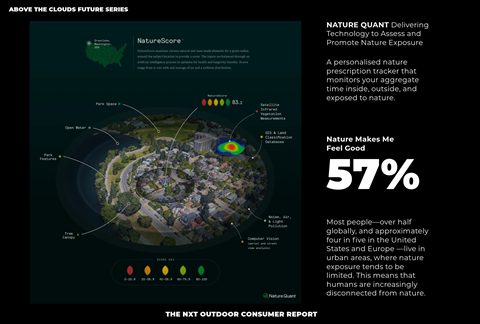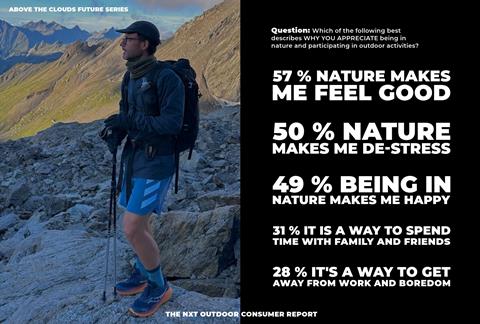In an increasingly complex and fast-paced world, where the pressures of modern life weigh heavily on consumers, a profound shift is taking place in how people interact with the outdoors. The concept of Trailfulness—a blend of mindfulness and trail-based outdoor activities—is emerging as a powerful antidote to stress, anxiety, and the mental fatigue that many face today. For outdoor and sports brands, this trend offers a unique opportunity to align the brand with the evolving needs of the audience, positioning products and services as essential components of mental well-being.

The strategic rise of trailfulness
The NXT Nordic Outdoor Consumer Report 2024 underscores a significant trend: consumers are increasingly seeking outdoor experiences that go beyond physical fitness and adventure. They are looking for emotional and psychological rejuvenation—a chance to find mental clarity, reduce stress, and connect with nature on a deeper level. 57% of consumers reported that being in nature primarily makes them feel good, and 50% engage in outdoor activities specifically to de-stress. These figures highlight a critical shift in consumer motivation, where mental well-being is becoming a primary driver for outdoor engagement.
For outdoor and sports brands, the rise of Trailfulness presents both a challenge and an opportunity. It challenges traditional notions of what outdoor activities are supposed to offer, pushing brands to rethink their value propositions. Simultaneously, it offers the opportunity to differentiate the brand by positioning it at the intersection of performance, adventure and mental wellness—a space that is becoming increasingly relevant to today’s consumers.
Strategic opportunities for brands
1. Positioning your brand as a mental wellness partner: The data is clear: consumers are turning to nature as a form of therapy. Brands that position themselves as partners in mental wellness can tap into this growing market. This means not only promoting the physical benefits of outdoor activities but also emphasizing how products and services contribute to mental well-being. Marketing campaigns could focus on the therapeutic aspects of nature, using storytelling to highlight personal journeys of mindfulness on the trail, or creating content that educates consumers about the mental health benefits of spending time outdoors.
2. Developing wellness-centric products: With the rise of Trailfulness, there is a growing demand for products that enhance the mental health benefits of outdoor activities. This could involve designing gear that prioritizes comfort and ease of use, creating tools that support mindfulness practices in nature, or offering experiences that cater to the wellness market, such as guided meditation hikes or nature retreats. The report’s findings, which show that 49% of consumers find happiness in nature, suggest that products supporting a more immersive and comfortable outdoor experience could deeply resonate with this audience.
3. Integrating Trailfulness into brand messaging: Trailfulness is not just a trend; it’s a lifestyle choice that consumers are increasingly adopting. Brands should integrate this concept into their core messaging, making mental wellness a central theme. This could involve partnerships with mental health organizations, collaborations with wellness influencers, or the creation of platforms that allow consumers to share their Trailfulness experiences. By positioning the brand as a champion of mental well-being, brands can build a stronger, more emotional connection with the audience, fostering loyalty and long-term engagement.

Connecting Trailfulness with broader industry trends
The concept of Trailfulness does not exist in a vacuum; it is deeply interconnected with other trends shaping the outdoor industry.
1. The Creative Collectives: As outdoor activities increasingly serve as cultural hubs that blend creativity with community, the rise of The Creative Collectives aligns closely with the principles of Trailfulness. Both trends emphasize the role of nature as a source of inspiration, creativity, and social connection. The report indicates that 26% of consumers look to nature for inspiration, suggesting that brands can create products and experiences that cater to both the creative and wellness needs of their consumers. This could involve hosting outdoor art workshops, developing products that support creative expression in nature, or sponsoring events that bring together artists, wellness enthusiasts, and outdoor adventurers.
2. The role of sustainability: There is a natural synergy between Trailfulness and sustainability. As consumers seek mental well-being through nature, they become more invested in protecting the environment that provides them with these benefits. The report shows that individuals who engage in outdoor activities are more likely to adopt sustainable practices. Brands can leverage this connection by emphasizing that protecting nature is essential for maintaining its mental health benefits. This could involve promoting sustainable product lines, launching environmental initiatives, or partnering with conservation organizations to protect the natural spaces that are so integral to the Trailfulness experience.
3. Emotional and social drivers: The Trailfulness trend also aligns with the broader emotional and social drivers of outdoor activities. Consumers are not just seeking solitude in nature; they are looking for meaningful connections with others who share their values. Brands that focus on fostering these social connections—whether through community-building events, social media platforms, or collaborative projects—will be well-positioned to capture the loyalty of consumers who value both mental wellness and social engagement.
Strategic reflections: Embedding trailfulness into brand strategy
The rise of Trailfulness is more than just a response to the stresses of modern life; it’s a reflection of a broader cultural shift towards prioritizing mental health and well-being in all aspects of life, including outdoor activities. For brands in the outdoor and sports industries, this presents a compelling opportunity to differentiate themselves by aligning with the wellness needs of their consumers.
To succeed, brands must go beyond traditional marketing tactics and fully integrate the principles of Trailfulness into their product development, messaging, and community engagement strategies. This means positioning nature not just as a playground for adventure, but as a sanctuary for the mind—a place where consumers can reconnect with themselves, find peace, and gain clarity.
By embracing Trailfulness, brands can build stronger, more meaningful connections with their audience, fostering loyalty and trust in an increasingly competitive market. As consumers continue to seek mental well-being through nature, the brands that lead with a focus on Trailfulness will be the ones that resonate most deeply, capturing the hearts and minds of today’s outdoor enthusiasts.
The path forward: Trailfulness as a core brand value
For outdoor and sports industry leaders, the rise of Trailfulness offers a strategic pathway to build a foundation for long-term success. The future of outdoor activities is not just about physical endurance or adventure; it’s about mental clarity, emotional well-being, and meaningful connections. Trailfulness is a key to unlocking this future, and the brands that embrace it will lead the way in shaping a new era of outdoor experiences.
Is your brand ready for the sustainable consumer?
Eco-conscious consumers are reshaping the sports and outdoor industry. Discover the latest trends and strategies to stay ahead in our special series.
>> Find out moreFredrik Ekström
Fredrik Ekström, a brand strategist and founder of Above The Clouds, brings over 20 years of expertise in consumer insights, brand development, and strategic communication. With a unique understanding of the evolving landscape of sustainability and consumer behavior within the outdoor and lifestyle industries, Fredrik unveils key findings from his latest report, THE NXT NORDIC OUTDOOR CONSUMER 2024. This report draws on data from 2,500 individuals across Sweden, Finland, Norway, and Denmark.








